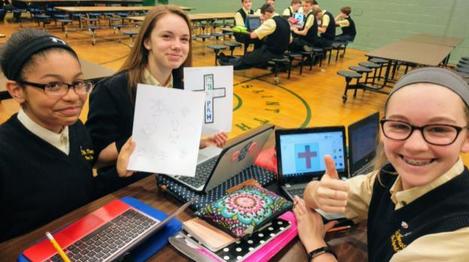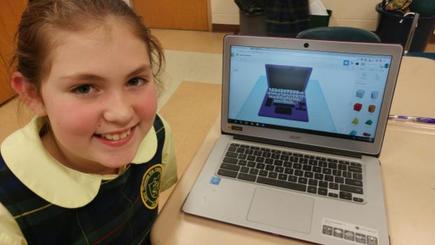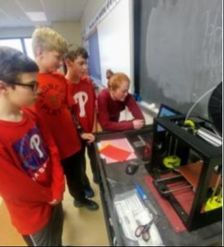When It Comes To 3D Printing...Trust The Process

In the world of education, innovations are emerging at a fast, never-ending clip. As teachers and administrators, we are constantly looking for the latest technological advancements to engage our students by helping to bring their learning to life. One of the most recent additions to our technology toolbox is the 3D printer. While it is fascinating and full of possibilities, it can can also be mysterious and daunting.
As educators when we “trust the process” - that is the, 3D design process, we give our students valuable learning experiences, often even without the actual printer itself:
The Design Stage: Presenting students with an engineering design project, the task of creating a community, or problem-solving through an invention are various ways to begin. Once an idea has been discussed and sketched, a 3D modeling program like Tinkercad or SketchUp, both free, can give students a digital platform to design a 3D object. Tinkercad also has a Gallery from which students can find and modify designs already created by others. Any content area can be connected to the object, and, in particular, mathematics concepts can be reinforced using the software itself. Objects can then be prepared for 3D printing or not. Often times, the students are content to share their ideas transformed into 3D models on the computer.
As educators when we “trust the process” - that is the, 3D design process, we give our students valuable learning experiences, often even without the actual printer itself:
The Design Stage: Presenting students with an engineering design project, the task of creating a community, or problem-solving through an invention are various ways to begin. Once an idea has been discussed and sketched, a 3D modeling program like Tinkercad or SketchUp, both free, can give students a digital platform to design a 3D object. Tinkercad also has a Gallery from which students can find and modify designs already created by others. Any content area can be connected to the object, and, in particular, mathematics concepts can be reinforced using the software itself. Objects can then be prepared for 3D printing or not. Often times, the students are content to share their ideas transformed into 3D models on the computer.

The Print Preparation Stage: Again, this stage has great educational value with or without a 3D printer. Steeped in math, software like Cura, also free, can be downloaded to show students the different things they can do to their objects prior to sending it to the printer. Scaling it, changes the infill, and determines if the model needs support constructed in order to produce a successful print. These are important opportunities for young learners to engage in real world problem-solving.
The 3D Printing Stage: If you are fortunate to have a 3D printer in your school or county, you can then print the fruits of your students’ labor. It may take trial and error, but 3D printing offers great lessons in resourcefulness and troubleshooting. A school community grows more comfortable and confident with each print job, whether successful or not. This teaches students, that failure is part of the path to success. They should not give up at the first challenge or hurdle, but instead use it as a learning opportunity to guide future prints.
The 3D Printing Stage: If you are fortunate to have a 3D printer in your school or county, you can then print the fruits of your students’ labor. It may take trial and error, but 3D printing offers great lessons in resourcefulness and troubleshooting. A school community grows more comfortable and confident with each print job, whether successful or not. This teaches students, that failure is part of the path to success. They should not give up at the first challenge or hurdle, but instead use it as a learning opportunity to guide future prints.

Our teachers at Saint Thomas the Apostle have created sacramentals in religion, artifacts in social studies, and cells in science with our Lulzbot Mini. If a school is without a printer, there are options. One, you can collaborate with a school that does, sending your students’ models in STL format to a class in another school willing to do the printing. Two, many intermediate units, such as the DCIU, will rent or check out a 3D printer once the teacher is trained to operate it.
In the world of educational technology, we are always at some point of the process. Our goal is to assess where we are and keep moving forward. 3D printing gives our students - and teachers - the chance to do just that.
Bridget Algeo
Saint Thomas the Apostle
In the world of educational technology, we are always at some point of the process. Our goal is to assess where we are and keep moving forward. 3D printing gives our students - and teachers - the chance to do just that.
Bridget Algeo
Saint Thomas the Apostle
Bridget loves both teaching and football. Connect with her on Twitter @bigplay_mom and follow her blog Rare Breed Nation.
Rare Breed Nation is about the forty-four year career of Lansdale Catholic Head Football Coach and her father, Coach Jim Algeo.
Rare Breed Nation is about the forty-four year career of Lansdale Catholic Head Football Coach and her father, Coach Jim Algeo.
AOPTech would like to thank Ms. Algeo for sharing her classroom expertise with us.
We also would like to thank her principal, Mr. John Keeley for nominating her.
If you know of a teacher that should be featured next month let us know here - Nominate a Teacher
We also would like to thank her principal, Mr. John Keeley for nominating her.
If you know of a teacher that should be featured next month let us know here - Nominate a Teacher